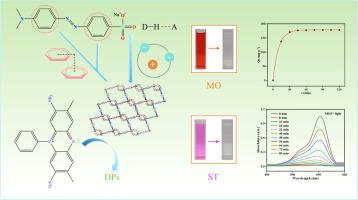三重互穿双功能Co-MOF的合成与结构及其光催化降解红花红T和吸附去除甲基橙的研究
IF 4.7
2区 化学
Q2 CHEMISTRY, PHYSICAL
引用次数: 0
摘要
本研究采用溶剂热法合成了由4′-(4-羧基苯氧基)-4-联苯羧酸(H2L)和4,4′-双(咪唑基)联苯(bibp)构成的新型Co(II)基金属有机骨架[Co(L)(bibp)·0.5H2O]n,该骨架具有罕见的基于65·8拓扑结构的三维3重互穿骨架。采用SCXRD、PXRD、FT-IR、TGA、SEM、BET和UV-vis DRS等表征了Co-MOF的结构特征和稳定性。所制得的Co-MOF具有良好的稳定性和光催化去除有机染料污染物的双重功能。对阴离子染料甲基橙(MO)表现出优异的选择性吸附性能,吸附容量高达208.1 mg·g-1。通过动力学、等温线和热力学对吸附过程进行优化,发现吸附过程是自发的,主要是物理的,遵循伪一阶和Langmuir模型。此外,Co-MOF对阳离子染料藏红花T (ST)具有显著的光催化降解活性,在紫外光下80 min内可达到98.67%的降解率,并且在多个循环中保持较高的效率。自由基捕获实验发现超氧自由基(·O2-)是主要的活性物质。这项工作证实了所设计的Co-MOF是一种强大的多功能材料,能够将吸附和光降解结合起来,有效地修复复杂的废水。本文章由计算机程序翻译,如有差异,请以英文原文为准。

Synthesis and structure of a 3-fold Interpenetrated bifunctional Co-MOF for efficient photocatalytic degradation of safranin T and adsorptive removal of methyl orange
This study reports the solvothermal synthesis of a novel Co(II)-based metal-organic framework, namely [Co(L)(bibp)·0.5H2O]n, constructed from 4′-(4-carboxylphenoxy)-4-biphenyl carboxylic acid (H2L) and 4,4′-bis(imidazolyl)biphenyl (bibp), which displays an uncommon three-dimensional 3-fold interpenetrated framework based on 65·8 topology. The structural characteristic and stability of Co-MOF were characterized by SCXRD, PXRD, FT-IR, TGA, SEM, BET and UV-vis DRS. The obtained Co-MOF demonstrates excellent stability and dual functionality for the removal of organic dye pollutants via adsorption and photocatalysis. It exhibited outstanding selective adsorption performance for the anionic dye methyl orange (MO), with a high capacity of 208.1 mg·g-1. The adsorption process, which was optimized by examining kinetics, isotherms, and thermodynamics, was found to be spontaneous and predominantly physical, following the pseudo-first-order and Langmuir models. Furthermore, Co-MOF possessed remarkable photocatalytic activity for degrading the cationic dye safranine T (ST), achieving 98.67 % degradation within 80 min under UV light and maintaining high efficiency over multiple cycles. Radical trapping experiments identified superoxide radicals (·O2-) as the primary active species. This work confirms that the designed Co-MOF is a robust and multifunctional material capable of integrating both adsorption and photodegradation for the efficient remediation of complex wastewater.
求助全文
通过发布文献求助,成功后即可免费获取论文全文。
去求助
来源期刊

Journal of Molecular Structure
化学-物理化学
CiteScore
7.10
自引率
15.80%
发文量
2384
审稿时长
45 days
期刊介绍:
The Journal of Molecular Structure is dedicated to the publication of full-length articles and review papers, providing important new structural information on all types of chemical species including:
• Stable and unstable molecules in all types of environments (vapour, molecular beam, liquid, solution, liquid crystal, solid state, matrix-isolated, surface-absorbed etc.)
• Chemical intermediates
• Molecules in excited states
• Biological molecules
• Polymers.
The methods used may include any combination of spectroscopic and non-spectroscopic techniques, for example:
• Infrared spectroscopy (mid, far, near)
• Raman spectroscopy and non-linear Raman methods (CARS, etc.)
• Electronic absorption spectroscopy
• Optical rotatory dispersion and circular dichroism
• Fluorescence and phosphorescence techniques
• Electron spectroscopies (PES, XPS), EXAFS, etc.
• Microwave spectroscopy
• Electron diffraction
• NMR and ESR spectroscopies
• Mössbauer spectroscopy
• X-ray crystallography
• Charge Density Analyses
• Computational Studies (supplementing experimental methods)
We encourage publications combining theoretical and experimental approaches. The structural insights gained by the studies should be correlated with the properties, activity and/ or reactivity of the molecule under investigation and the relevance of this molecule and its implications should be discussed.
 求助内容:
求助内容: 应助结果提醒方式:
应助结果提醒方式:


